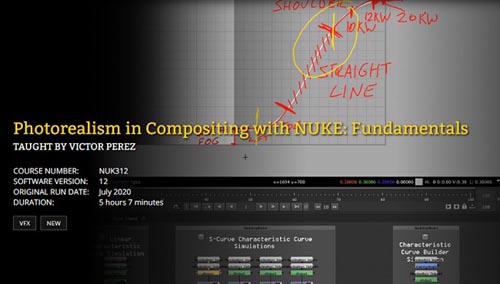by cod2war on 05 August 2020 - 548 views - 0 comments
FXPHD - NUK312 Photorealism in Compositing with NUKE Fundamentals

FXPHD ? NUK312 Photorealism in Compositing with NUKE Fundamentals
Info:
Course syllabus:
CLASS 1: MIND-MAPPING CONCEPTUALISATION OF LIGHT
In order to study all factors that influence our perception of light we have to structure a strategy of analysis of light by tracking the events that condition the appearance of the rays of light of the observed area from the source to the sensor. A mind map will develop a structured thought and a procedure which is essential for such a complex phenomena. A few examples show the mind map in action.
CLASS 2: PRIMARY COLOR TRANSFORMATION OPERATORS
Operators constitute the essential tool for the manipulation of the image in order to model the desired intent. Here you understand all basic primary operations, its mathematical correspondence, practical observation of values and distribution on the LUT analytics. Focus on the fundamentals of the Grade node and the advance application on the ColorLookUp node.
CLASS 3: DECODING THE CHARACTERISTIC CURVE FOR MATCHING
The Characteristic Curve is the DNA of any support and it conditions the look of an image captured to enable you to reproduce it you first need to understand it. This class demystifies this curve and starts bridging concepts and operations from the previous class to start building the fundamentals of the CG matching.
CLASS 4: SECONDARY OVERALL COLOR OPERATORS
Understanding brightness, contrast and saturation. Different approaches to target light intensities for integration and effects based on ranges and area isolation. Analysis of relative values of the image such as Saturation and the characteristics of the non-reversible operations.
CLASS 5: ART AS SOURCE OF REFERENCE
Developing a visual narrative style and using light as a creative and narrative medium. A brief history of how painters use light and technique to tell stories beyond paint. Fundamentals of visual storytelling.
CLASS 6: TRUST YOUR VALUES
Procedural guidelines for self-checking the Viewer. Using and understanding the Pixel Analyzer, transforming color from a perceptive point, TMI vs HSV vs RGB models. The mathematical match and the visual check.
DOWNLOAD HERE :
https://rapidgator.net/file/ca28eeacd786566a01d5cf344e2c59ba/FXPHDNUK312PhotorealisminCompositingwithNUKEFundamentals.part1.rar.html
https://rapidgator.net/file/a53c7eae878f7c9f8841debb354eb349/FXPHDNUK312PhotorealisminCompositingwithNUKEFundamentals.part2.rar.html
https://rapidgator.net/file/0cb5f0e2ccbbf6152b48498076b39afc/FXPHDNUK312PhotorealisminCompositingwithNUKEFundamentals.part3.rar.html
https://rapidgator.net/file/0743ee0b40c9c49a8c7635052237a265/FXPHDNUK312PhotorealisminCompositingwithNUKEFundamentals.part4.rar.html
Tags:
RELATED NEWS
![[Tutorials] Lynda - NUKE 9 Essential Training (updated Oct 04, 2014)](http://i.imgur.com/OaSW520.jpg)


![[Plugins] Gumroad - Color Constructor 0.1.7 Win/Mac](http://i.imgur.com/3ObakCi.jpg)